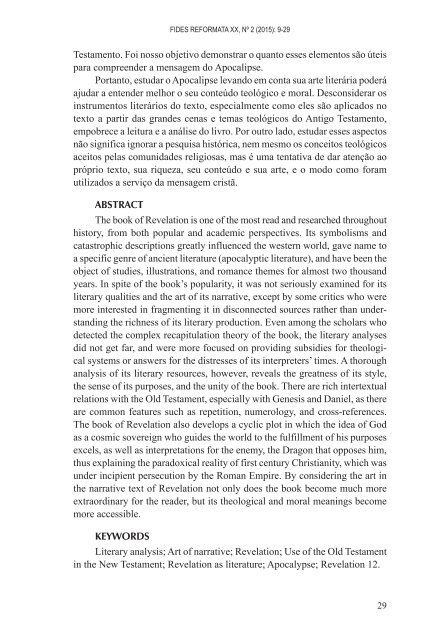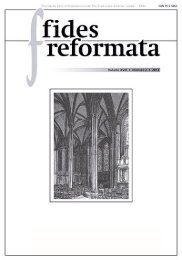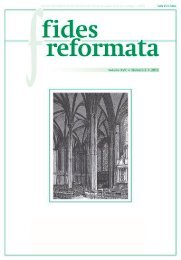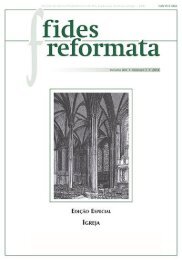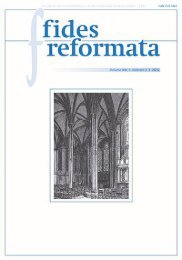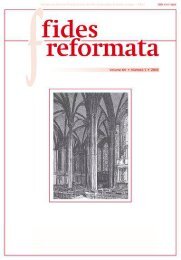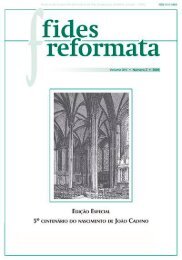Fides 20 N2 - Revista do Centro Presbiteriano Andrew Jumper
Revista Fides Reformata 20 N2 (2015)
Revista Fides Reformata 20 N2 (2015)
Create successful ePaper yourself
Turn your PDF publications into a flip-book with our unique Google optimized e-Paper software.
FIDES REFORMATA XX, Nº 2 (<strong>20</strong>15): 9-29<br />
Testamento. Foi nosso objetivo demonstrar o quanto esses elementos são úteis<br />
para compreender a mensagem <strong>do</strong> Apocalipse.<br />
Portanto, estudar o Apocalipse levan<strong>do</strong> em conta sua arte literária poderá<br />
ajudar a entender melhor o seu conteú<strong>do</strong> teológico e moral. Desconsiderar os<br />
instrumentos literários <strong>do</strong> texto, especialmente como eles são aplica<strong>do</strong>s no<br />
texto a partir das grandes cenas e temas teológicos <strong>do</strong> Antigo Testamento,<br />
empobrece a leitura e a análise <strong>do</strong> livro. Por outro la<strong>do</strong>, estudar esses aspectos<br />
não significa ignorar a pesquisa histórica, nem mesmo os conceitos teológicos<br />
aceitos pelas comunidades religiosas, mas é uma tentativa de dar atenção ao<br />
próprio texto, sua riqueza, seu conteú<strong>do</strong> e sua arte, e o mo<strong>do</strong> como foram<br />
utiliza<strong>do</strong>s a serviço da mensagem cristã.<br />
abstract<br />
The book of Revelation is one of the most read and researched throughout<br />
history, from both popular and academic perspectives. Its symbolisms and<br />
catastrophic descriptions greatly influenced the western world, gave name to<br />
a specific genre of ancient literature (apocalyptic literature), and have been the<br />
object of studies, illustrations, and romance themes for almost two thousand<br />
years. In spite of the book’s popularity, it was not seriously examined for its<br />
literary qualities and the art of its narrative, except by some critics who were<br />
more interested in fragmenting it in disconnected sources rather than understanding<br />
the richness of its literary production. Even among the scholars who<br />
detected the complex recapitulation theory of the book, the literary analyses<br />
did not get far, and were more focused on providing subsidies for theological<br />
systems or answers for the distresses of its interpreters’ times. A thorough<br />
analysis of its literary resources, however, reveals the greatness of its style,<br />
the sense of its purposes, and the unity of the book. There are rich intertextual<br />
relations with the Old Testament, especially with Genesis and Daniel, as there<br />
are common features such as repetition, numerology, and cross-references.<br />
The book of Revelation also develops a cyclic plot in which the idea of God<br />
as a cosmic sovereign who guides the world to the fulfillment of his purposes<br />
excels, as well as interpretations for the enemy, the Dragon that opposes him,<br />
thus explaining the para<strong>do</strong>xical reality of first century Christianity, which was<br />
under incipient persecution by the Roman Empire. By considering the art in<br />
the narrative text of Revelation not only <strong>do</strong>es the book become much more<br />
extraordinary for the reader, but its theological and moral meanings become<br />
more accessible.<br />
keywords<br />
Literary analysis; Art of narrative; Revelation; Use of the Old Testament<br />
in the New Testament; Revelation as literature; Apocalypse; Revelation 12.<br />
29


